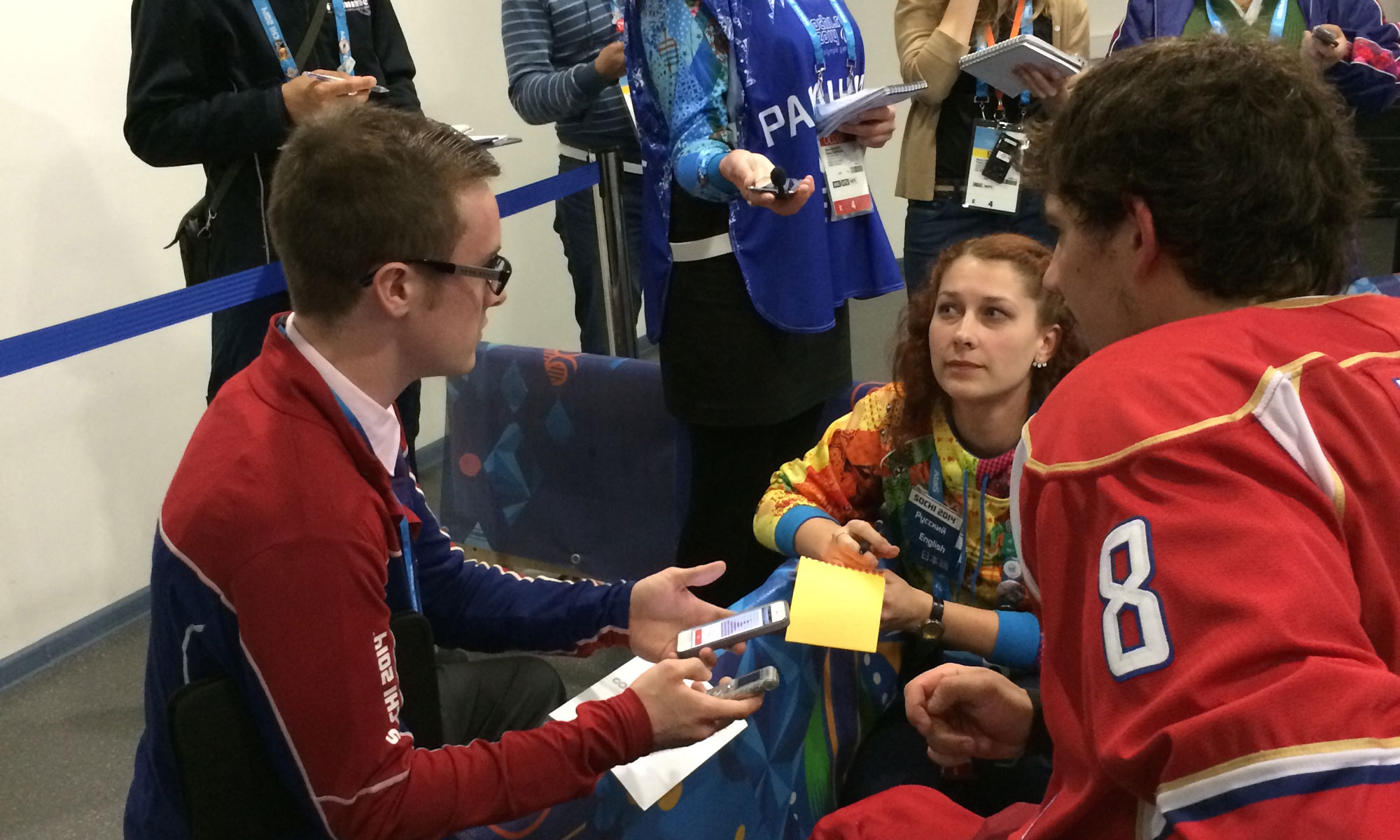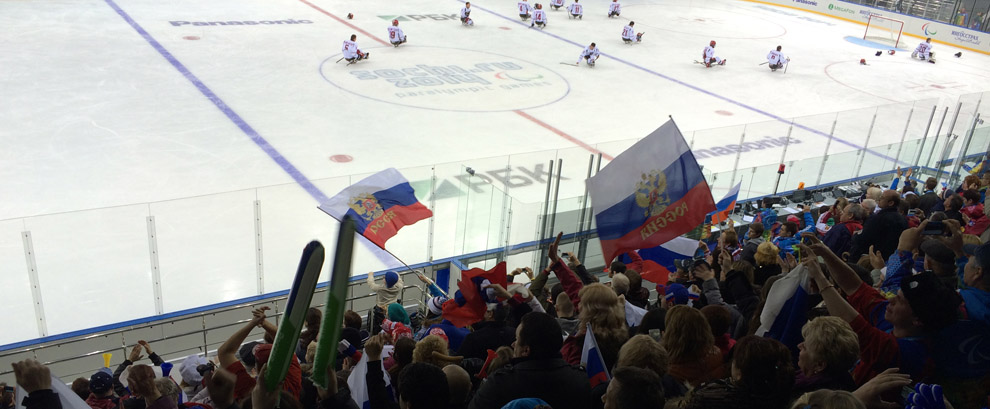This article first appeared on Abilities.ca on August 5, 2014.
It’s two days before the opening ceremonies at the 2014 Paralympic Winter Games: I’m walking through a relatively empty and quiet Olympic Park in Sochi, where the Olympic rings are being transformed into the Paralympic agitos. It’s hard to believe that another massive international event will soon take place here. Right now, the atmosphere feels more hangover than celebration.
Not for long though, as the Paralympics, a once obscure athletic competition, continues to muscle its way into the global spotlight and into the homes of millions. “If you compare Paralympic sport from 10 years ago with what we have now, the product we have to offer is far better,” says Craig Spence, communications and media director with the International Paralympic Committee (IPC).
A scene inside Sochi’s Shayba Arena near the end of the Paralympics highlights his point. It’s the gold-medal match in sledge hockey between Russia and the US. The game is sold out and the home crowd is chanting “RUS-SEE-A” every time the home team touches the puck. And there, crammed into a section behind the penalty boxes, is a throng of representatives from the world’s media—reporters, camera operators, photographers and more—all of whom are contributing to a level of hype the likes of which the Paralympics has never known.
According to the IPC, more people are tuning into the Paralympics on television than ever before. One example: the Summer Paralympics in London 2012, when 930 million people tuned in from China and 424 million from the UK. However, this compares with only nine million viewers from the US and figures were even worse in Canada, with a cumulative audience of 1.6 million.
“If you put that into perspective with the size of the countries,” says Spence, “clearly more needed to be done in America, and I think what we’ve managed to correct between London and Sochi is coverage in America.”
A model for success
According to the IPC, NBC saw the success that Channel 4 (the UK broadcaster that televised the London Paralympics) enjoyed and took note. Over 12 days, Channel 4 put on more than 500 hours of coverage, with 40 million people tuning in. During the opening ceremonies more than 11 million people were watching, among the highest ratings in over 10 years for the station.
“I would be lying to you if I said that we weren’t sort-of surprised by how well the London Paralympics did for us,” says Jamie Aitchison, commissioning editor of sport at Channel 4. “We didn’t know whether the British public were going to love the Paralympics as much as they did the Olympics because no one had done it to a scale like this before. I guess the marketing campaign was one of the main tenets of our success. I think that saw a change of gear in the British public.”
Channel 4’s marketing campaign was a mix between their “Meet the Superhumans” television commercials and a poster campaign with the phrase “Thanks for the Warm-up,” which was displayed post-Olympics. (Watch the “Meet the Superhumans” commercial at www.youtube.com/watch?v=kKTamH__xuQ.) The marketing campaign was so widespread and effective that it ended up reaching more than 85 per cent of the UK population.
Shifting attitudes
There are mixed opinions as to when exactly the shift in the Paralympic movement’s media popularity started. Some say it was Beijing 2008, others Vancouver 2010.
Gary Kingston is a reporter for the Vancouver Sun and Sochi 2014 marked the sixth consecutive Paralympic Games he’s covered. Kingston says London 2012 was responsible for exposing just how good the Games really are.
“Oh absolutely, it was the best-covered Games I have ever seen. I talk about the work that Channel 4 did in Britain, but the other thing, too, was the print coverage,” says Kingston. “I think that broadcast people were blown away by what Channel 4 did and the amount of coverage that they put into it, and it seemed to pay off.”
Sochi 2014 marked a new chapter in Canada for the Paralympics, with more coverage than ever before. Unlike the previous two Games in which Rogers Communications and Bell Canada owned the Canadian consortium rights, this time around it was the Canadian Paralympic Committee that purchased the broadcast rights. The IPC does not disclose figures on how much each country pays for the broadcast rights, but will say that it varies from country to country depending on demand.
“It was actually really unique and Canada had probably the largest coverage over various platforms than any for other Games,” says Brian Perdue, director of programming at Accessible Media Inc. (AMI).
The Canadian Broadcasting Corporation (CBC), along with Radio-Canada, led the coverage while Sportsnet, AMI, Yahoo Canada Sports and SendtoNews also played parts in showing aspects of the Games. According to the CBC, almost nine million people tuned in to the English-language broadcasts throughout the Sochi 2014 Paralympic Winter Games.
For CBC’s Jeffrey Orridge, having the Canadian Paralympic Committee appoint the Games to Canada’s public broadcaster worked out well. “It was huge for us,” he says. “We’re very, very pleased with how things came about and certainly our goal as a public broadcaster is to serve underserved properties and populations. Whether it be amateur sport or Paralympics, that’s what we endeavour to do and I think we certainly met our goals.”
The view of the athletes
Brad Bowden is a forward on the Canadian sledge hockey team and Sochi 2014 was his sixth Paralympics. He says the shift in media coverage since he first started competing on the international stage has been eye-opening.
“I remember having to explain to everybody what sledge hockey was,” he says, “let alone the Paralympics—trying to explain that it’s not the Special Olympics and so forth. But now it’s pretty cool. I just tell somebody I play sledge hockey and they say, ‘Oh I saw that online’ or ‘I saw it on TV’ or ‘I saw it on TSN’ and what-not. It’s come a long way, that’s for sure.”
The explanation for the rise in popularity has been pegged on one thing—the athletes are just that good. One example is French star Marie Bochet, who cranked out four gold-medal performances in alpine skiing at Sochi 2014. Bochet says the French had the chance to watch all the national team’s races live on various national television channels, while in Vancouver you had to look hard online to find a few videos on the internet.
Back to the future
The future of Paralympic coverage around the world is promising. Here, the Canadian Paralympic Committee is in discussions with its broadcast partners from Sochi with respect to a repeat performance for the Toronto 2015 Para-Pan American Games and the 2016 Rio Olympics.
The IPC is now looking even further ahead. “I think Tokyo 2020 has the potential to blow everything out of the water,” says Spence. “It is the Games to end all Games in terms of success because everything is there. There’s great accessibility in the city, we’ve got six years to prepare for it, there are some great sponsors that will come on board, the facilities will be amazing and the television coverage will be amazing. It is a Games we can really transform with.”
Ryan McKenna is an ice-sledge hockey and swimming reporter with the International Paralympic Committee, and is also a journalism student at Ryerson University in Toronto.

